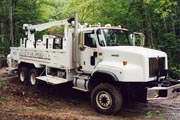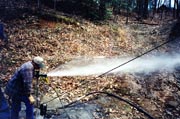
McGinn stresses, “We like to be very precise when we tell the drillers what the production is after we frac the well. We have a piece of equipment we use for production testing - a tandem-axle trailer with a big hydraulic wheel on it. We can set a 3-HP pump as deep as 600 feet. It's all self-contained. The hydraulic system lowers the pump and we have a generator that operates the pump. We can do drawdown; we can do recovery tests. We have three sonar depth finders that will measure the water level within an inch or two, and we can do it with the water moving, so we can test recovery rates. We can tell exactly where the water is after we start pumping. For example, if we pumped a well for an hour and took out 1,000 gallons of water, and, after using the sonar, we found that the water level had gone down by 500 gallons, it doesn't take a rocket scientist to do the math and discover that the well was making 500 gallons while we were doing this. “You can't test a well within two days after hydrofracturing it,” McGinn cautions. “We let them sit for at least 48 hours - and with our schedule, usually longer than that.” In explanation, he tells us, “The water level doesn't return to some form of equilibrium for about 48 hours. It is labor-intensive to go back again and spend half a day there testing it, but we're committed to making sure that it's right, so that's what we do. And that makes the drillers happy.”

Serving the Customers
The good people at Mountain Hydrofracture share the mindset that they are working for two customers in any given situation. “For example,” McGinn says, “I'll have one particular driller call me and say, 'I've got three wells for you to do.' He batches them together because it's about a 60-mile run over there. He may ask me to talk to the customer; he may not. Most of the drillers will refer us to somebody and that person will wind up calling us asking us about hydrofracturing and how it works and what to expect and that sort of thing. For the majority of our work - probably 90 percent of it - either the driller calls us or he has the customer call us. So we view that as having two customers - the drilling contractor and whoever owns the well.And you don't want to upset your customers by stepping on their toes, right, Mike? “We won't do any projects that would displace the drilling contractor. If someone asks us if we can set a pump for him, well, of course, we could; but we won't. We do not encroach on any service that the driller can provide. If the driller wants to pull a pump before we get there, that's fine; if he can't get to it and wants us to do it, that's fine, too.”
As for other sources of business, McGinn tells us, “There are a lot of big developers in our area,” which he describes as a 100-mile radius. “I really don't want the rig more than 100 miles away. We won't go 100 miles to do one well. The majority of our runs are within 40 to 50 miles; a lot of them are within 15 miles. We're in an area where there is huge development going on right now - lots and lots of summer homes. Most of these recreational-type homes are situated in places that do not have municipal water. We have about a dozen developers that know what we can do and they'll call us directly. They know basically where to stop drilling if they don't have water. They've had successful experiences with us in the past.”
“Our marketing centers around satisfied customers,” McGinn stresses. “Our company policy is, if we create a customer expectation, there are only two things that are going to happen. Either we meet it or we change it. We don't ever not come through. One thing that we do is when we tell somebody that we're going to be there, if for some reason we can't make it within 15 minutes of the designated time, they'll get a phone call.” He says that blows away some of Mountain Hydrofracture's customers, who've experienced contractors disappearing for days on end.
Defining Terms
McGinn describes hydrofracturing as “A high-value business. We're in the business of getting people water; we're not simply in the business of pressurizing water wells. The people who don't have water or don't have enough water are in a real jam. In a high percentage of the time, we're able to fix their problems. The customers don't really care about a hole in the ground; they care about their water. That's how we view the business.”In the instances where hydrofracturing doesn't work, “The primary reason is that there isn't any water there,” he explains. “If it's there, we can get it. Even if it's close by, we probably can get it. We've had situations where there are two new wells - 100 feet apart. We'll be hydrofracturing one well and we'll routinely blow the cap off the other well. We blew water out of one that was 50 feet away. So we know the effective reach probably is between 50 feet and 100 feet. Occasionally, a well just loses production over time. More often than not, unless there's an earthquake or something has been dynamited - we've had those things happen - we can bring back an old well.
“Calculate the area of a circle like that and compare it to a 6-inch hole you drilled into the ground and the assumption that the only water you have there is where that 6-inch hole intersected a water-bearing fissure. We have a better chance of getting water than the driller does.”
Explaining how hydrofracture works, McGinn says, “It's relatively simple. The amount of pressure required to neutralize the weight of overburden in a rock formation above any particular spot is approximately 1 psi per vertical foot. Assume we set a packer 200 feet in the ground and we lock the well closed. We bring the pressure below the 200 feet. It only takes 200 psi to neutralize the weight of the stuff above it. So if I put 2,000 pounds of pressure - which we are entirely capable of doing - on that formation, essentially what is done is the formation gets jacked up. It might only be a millimeter or two but when the formation is disturbed like that, little cracks get wedged open and little rock granules are held in there. While water is moving away from the well, the pressure begins to bleed off because the water is going out into the formation. That's when you know you have the formation open - it goes from 2,000 PSI, sits there for a minute and then the pressure begins to drop. So you're pushing those little rock granules into there and when the pressure on the formation is released, those little rock granules are holding open the cracks. In oil and gas well development, they use nylon beads to perform that same function. So, essentially what you are doing is using the water as a wedge and forcing it into the cracks to make the cracks wider. You're applying hydraulic pressure to the cracks that already are there.
“Sometimes the results can be very dramatic,” McGinn relates. “We've had some wells do some wild things. Every now and then, we'll cause one to become artesian. We've had three or four in the past 12 months where we got into a very high-volume, low-pressure situation where, for example, the well that had water standing 50 feet from the surface in a 400-foot well was making half-a-gallon a minute. After hydrofracturing, the water went down to 150 feet - almost immediately. Normally, you like it to go down nice and easy, but this one just went whoosh! When we went back to test it, the water was at 150 feet - but the thing was making 20 gallons a minute.”
Asked about failed hydrofracturing efforts, McGinn offers, “Our success rate probably is similar to what everybody else claims - 90 percent or 95 percent,” adding, “And I consider it successful if the well can be used for its intended purpose.”
McGinn points out a distinction that some well owners don't fully understand. “We all talk about gallons per minute, but we don't use water in gallons per minute; more accuurately, we use it in gallons per day,” he explains. “There is a language being spoken by the drillers to the customers that might not compute with them. I think it's better to tell somebody that the average family of 2.5 people uses around 400 gallons per day. If you've got hot tubs and golf courses and the like, then you add on to that. The water consumption is not evenly distributed throughout the day. It's high in the morning and high at night. You need a combination of production and storage to meet those needs. I had a guy call me saying he needed his well hydrofractured because he's only getting a gallon a minute. I said, 'OK. Would you rather get 1,440 gallons per day?' He said, 'Oh, heck yeah.' I told him, 'Well, that's what a gallon a minute is. You really don't need your well hydrofractured. Call us if you run out of water.'"
Looking Ahead
“Right now in the short term, we're running at a rate that is real comfortable for us,” McGinn says of Mountain Hydrofracture's business situation. “Our market is going to be solid. Our business has grown every year. If we had to put on a second rig, someone else would have to run it, and we have the same problem that everyone else has - finding reliable people to come work for us.”Explaining which market segments drive his business, McGinn says, “It's interesting. One year, a lot of work will come from one area and the next year, it will come from somewhere else. It's not predictable in terms of where it will be, but it will be somewhere. We had a run of huge, huge houses - $20 million homes - in downtown Atlanta where they were drilling wells so they wouldn't have to pay these outrageous municipal water prices to water their landscaping. In one mile-long street, we did about a dozen wells. Right now, most of the work is with homes that are on lakes up in north Georgia.”
Asked to offer advice to anyone interested in getting into the hydrofracture game, McGinn says, “This is not something where you can just flip a switch and go. It can take a few years to get established with the drillers, suppliers and people in related businesses. And if you've never operated this kind of equipment before, there's a learning curve. We lost a packer and several thousand dollars worth of equipment early on. We were talking about that incident about a year ago and we realized there was no way that would have happened to us today. We'd know how it occurred and how to best get out of it. All of that takes time, and now, we can minimize those types of incidents.”
ND
Report Abusive Comment